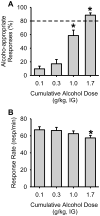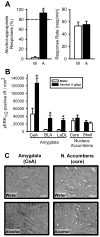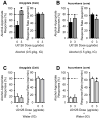Intra-amygdala inhibition of ERK(1/2) potentiates the discriminative stimulus effects of alcohol
- PMID: 22209853
- PMCID: PMC3268949
- DOI: 10.1016/j.bbr.2011.12.023
Intra-amygdala inhibition of ERK(1/2) potentiates the discriminative stimulus effects of alcohol
Abstract
Extracellular signal-regulated kinase (ERK(1/2)) has been implicated in modulating drug seeking behavior and is a target of alcohol and other drugs of abuse. Given that the discriminative stimulus (subjective/interoceptive) effects of drugs are determinants of abuse liability and can influence drug seeking behavior, we examined the role of ERK(1/2) in modulating the discriminative stimulus effects of alcohol. Using drug discrimination procedures, rats were trained to discriminate a moderate intragastric (IG) alcohol dose (1g/kg) versus water (IG). Following an alcohol (1g/kg) discrimination session phosphorylated ERK(1/2) (pERK(1/2)) immunoreactivity (IR) was significantly elevated in the amygdala, but not the nucleus accumbens. Therefore, we hypothesized that intra-amygdala inhibition of ERK(1/2) would disrupt expression of the discriminative stimulus effects of alcohol. However, intra-amygdala or accumbens administration of the MEK/ERK(1/2) inhibitor U0126 (1 and 3μg) had no effect on the discriminative stimulus effects of the training dose of alcohol (1g/kg). Contrary to our hypothesis, intra-amygdala infusion of U0126 (3μg) potentiated the discriminative stimulus effects of a low alcohol dose (0.5g/kg) and had no effect following nucleus accumbens infusion. Importantly, site-specific inhibition of pERK(1/2) in each brain region was confirmed. Therefore, the increase in pERK(1/2) IR in the amygdala following systemic alcohol administration may be reflective of the widespread effects of alcohol on the brain (activation/inhibition of brain circuits), whereas the site specific microinjection studies confirmed functional involvement of intra-amygdala ERK(1/2). These findings show that activity of the ERK signaling pathway in the amygdala can influence the discriminative stimulus effects of alcohol.
Copyright © 2012 Elsevier B.V. All rights reserved.
Figures





References
-
- Stolerman I. Drugs of abuse: behavioural principles, methods and terms. Trends Pharmacol Sci. 1992;13(5):170–6. - PubMed
-
- Bienkowski P, et al. Discriminative stimulus properties of ethanol in the rat: differential effects of selective and nonselective benzodiazepine receptor agonists. Pharmacol Biochem Behav. 1997;58(4):969–73. - PubMed
-
- Grant KA. Strategies for understanding the pharmacological effects of ethanol with drug discrimination procedures. Pharmacol Biochem Behav. 1999;64(2):261–7. - PubMed
Publication types
MeSH terms
Substances
Grants and funding
LinkOut - more resources
Full Text Sources
Miscellaneous

